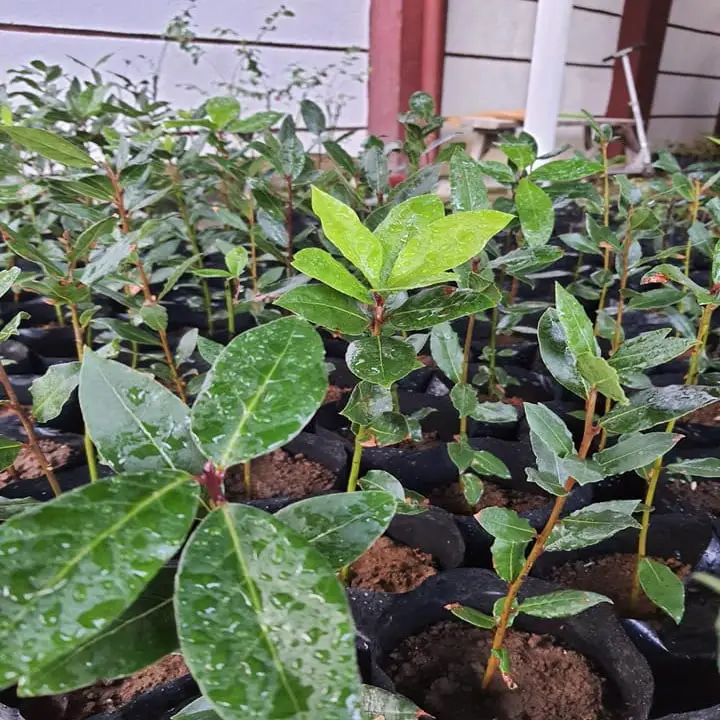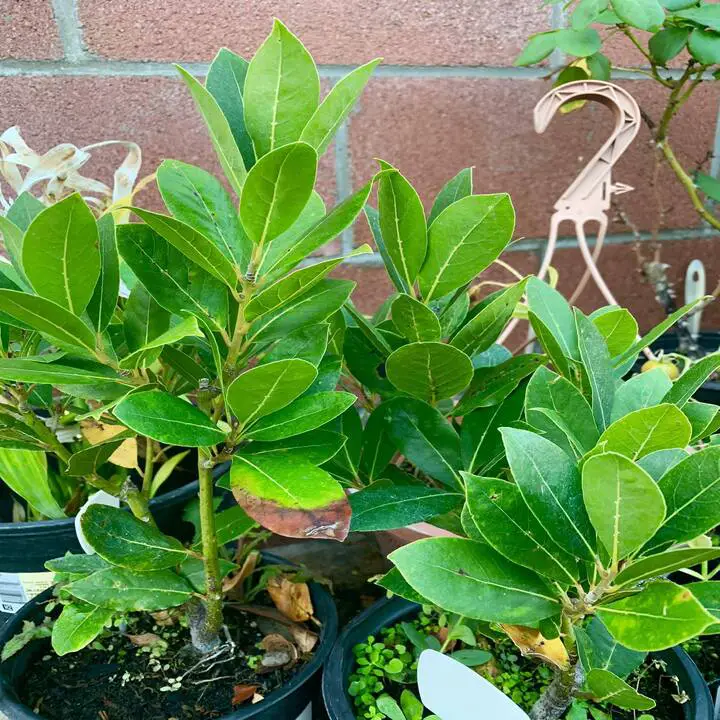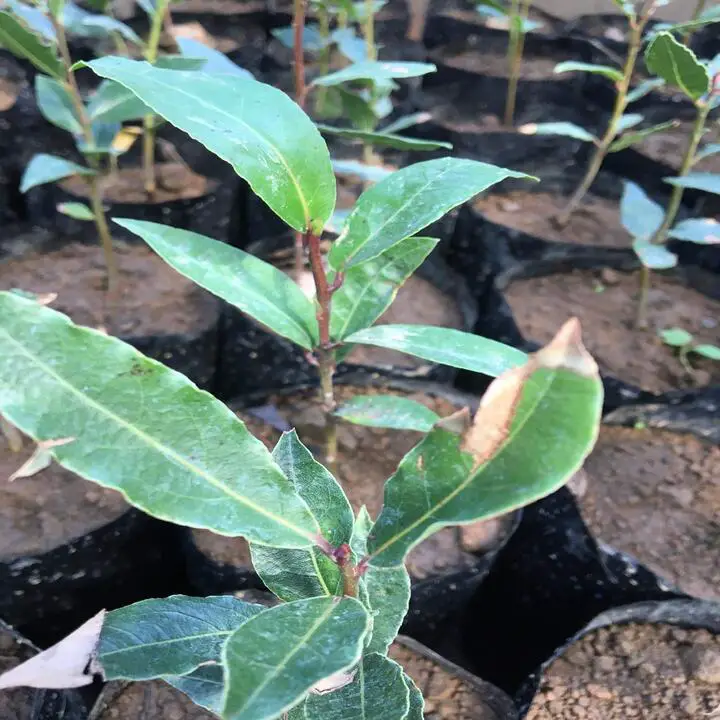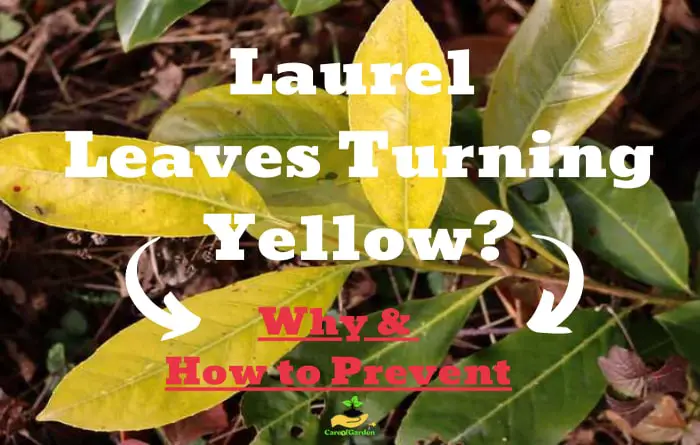Laurel Leaves Turning Yellow? (Why & How to Prevent)
Are your laurel leaves turning yellow and ruining the beauty of your garden? Don’t worry, you’re not alone and in this article, we will take a closer look at the main reasons and show you steps to treat and prevent yellowing leaves.
Laurel leaves are turning yellow due to several issues, including waterlogging, lack of nutrients, pest infestations, lack of sunlight, or too much sun exposure. To diagnose the problem, check the soil moisture levels and inspect the leaves for signs of pests or disease. Depending on the cause, you may need to adjust your watering schedule, provide additional nutrients, or treat the laurel plant for pests.
| Why Laurel Leaves are Turning Yellow: |
|---|
| 1. Waterlogging |
| 2. Lack of sunlight |
| 3. Lack of nutrients |
| 4. Sunburn |
| 5. Pests |
1. Waterlogging

Laurel trees (Laurus nobilis) require well-drained soil. If their roots become waterlogged, they will easily develop root rot, which turns the leaves yellow and causes the laurel to topple over.
Like many plants, the laurel hedge hates excess water. However, it is not very fragile, supporting without difficulty drying out or excess heat.
The problem is quite common when a laurel tree is potted, with a saucer underneath that collects water. Moisture rises into the earth through the drainage hole and soaks it.
The deepest roots soak in water continuously and are suffocated. They can no longer pump nutrients and feed the aerial parts, the leaves turn yellow and fall off. Then the whole shrub will wither, until it dies when all the roots have rotted.
How to Treat Laurel Yellow Leaves cause by Waterlogging
If you think your laurel has been overwatered, you may be able to save it. Transplant or repot the tree, trimming off diseased roots and removing all affected parts of the plant.
Evergreen shrubs like the laurel are very sensitive to longer dry or rainy periods. Loosen the soil if the laurel suffers from waterlogging and provide the plant with sufficient water during longer dry periods.
It is important to act quickly if the laurel shrub is young, because it has fewer roots and fewer resources; if it has begun to show symptoms, limit the amount of water you give it and empty the saucer after each watering.
To prevent yellowing leaves on laurel, plant in well-drained soil. When the topsoil is dry, water only when the roots are wet. Wet roots are often the underlying cause of yellowing leaves.
If many leaves have already fallen, remove them from their pots and cut off the damaged or rotten roots. Repot them in new, dry soil once they have recovered.
In summer, start watering every 2 to 3 days. And to make sure it’s the right time, you will push your finger several centimeters into the soil: if it is dry, watering is necessary, if it is fresh, you can wait.
2. Lack of Sunlight

The second reason why your laurel leaves are turning yellow is because they’re not getting enough sunlight during peak hours of growth.
The bay laurel hedge will need enough light to produce chlorophyll, which gives it its green color. If there is not enough light hitting the canopy during peak hours of growth (like mid-day), then the plant cannot produce chlorophyll and will turn yellow instead.
If you leave your tree outside for a few weeks during winter, then it’s more likely that it will die back completely due to lack of sunlight than if you had kept it inside all winter long where there would still be plenty of light hitting its canopy during peak hours of growth (like mid-day).
Laurus nobilis prefers to grow in well-drained soils, in a partially shaded or sunny place. It grows outdoors in warm climates or indoors or in greenhouses in cooler climates.
How to treat Lack of Sunlight
To treat lack of sunlight on laurel leaves, you will need to increase the amount of light hitting its canopy during the day. You can do this by moving your plant closer to a window if it is indoors, or using artificial lights like grow lights.
If you want to keep your laurel in its current location, then try increasing the amount of light hitting it by placing some reflective materials on top of its canopy like aluminum foil or white paper.
You can prune back some of the laurel leaves and branches to expose more of the plant to sunlight. Or you can wait until the summer when there will be more light available.
3. Lack of Nutrients
The third reason why the bay laurel tree has yellow leaves, is given by the lack of the following nutrients: nitrogen and iron.
Nitrogen deficiency
A uniform yellowing of bay laurel leaves, which occurs first on the older lower leaves and moves upwards, is probably due to a nitrogen deficiency in the laurel.
Nitrogen is one of the most important plant nutrients and if there is a lack of nitrogen, the older leaves usually turn yellow, starting at the top. With a persistent lack of nitrogen, yellowing affects your entire laurel hedge.
It would be good if you start fertilizing right at the beginning of the growing season in spring to prevent nitrogen deficiency.
In order to react quickly now, you can treat the plant with liquid foliar fertilizer (that is absorbed by the plant directly through the leaves and works very quickly).
Add a fertilizer rich in nitrates to the soil, taking care to follow the instructions so as not to burn the plant. A safer but slower option is to make amends with decaying organic matter to treat nitrogen deficiency.
However, nitrogen-rich fertilization should only be carried out until mid-August at the latest. Fertilizing beyond this period would encourage growth at the wrong time, and the plant may not mature sufficiently for the winter.
If possible, it would be good to repot the laurel into a larger planter, because then the roots have more opportunities to draw nutrients from the soil.
Iron deficiency
An iron deficiency is also called iron chlorosis and is a major problem in the garden caused by several problems, most of the time too alkaline soil or damaged roots.
Lack of iron decreases chlorophyll. Chlorophyll is responsible for giving plants a bright green color and for the process of photosynthesis.
When chlorophyll levels are low, this causes the process to stop working properly, resulting in the formation of yellow leaves that start at the edges and move inward while the laurel veins remain green.
To treat lack of iron in laurel leaves, you can use an iron chelate solution to water the soil. Follow the directions on the product label for mixing and application. It’s important that you don’t use more than recommended because too much iron can cause other problems in your laurel tree.
If you want to avoid using chemical treatments on your laurel tree, try adding more organic matter to the soil. This will help with drainage and aeration, which are two factors that contribute to iron chlorosis.
You can also try applying a liquid fertilizer with iron in it every few months throughout the growing season.
Treatment depends on the cause. If the soil is too moist or alkaline, mix organic matter, sulfur, or peat moss into the soil to correct pH and improve drainage.
4. Sunburn

The laurel tree leaves are turning yellow when they are exposed to too much sunlight leading to sunburn.
Summer leaf burns usually appear as yellow areas on a laurel leaf that are not evenly distributed. They are usually found on leaves that are particularly exposed to sunlight.
Sunburns can be caused by direct exposure (the most common when they are outdoor plants) or indirect exposure, through a window, in the case of indoor plants.
If you have recently replanted a laurel tree, it may be too sensitive to the sun and experience leaf burns if it is exposed to too much sunlight. Laurel shrubs should be given some time to adjust before they are exposed to increased levels of UV radiation again.
Even though the laurel hedge is relatively undemanding and requires only a sunny to partially shaded spot, it prefers a location in which it can receive morning sun.
The laurel will often react to all-day shading with yellowing of its leaves, since photosynthesis is slower under these conditions.
If you keep your laurels in full sun and leaves start turning yellow, there’s no need for concern. The leaves will likely grow back green as long as you give them some shade.
How to treat Yellow Leaves due to Sunburn
Sunburn is a common problem for plants, and it’s one that’s easily fixed. The best way to prevent sunburn in laurel trees is to keep them shaded during the hottest part of the day.
To solve this problem, nothing could be simpler: keep your laurel away from windows (especially if they are open in winter) and avoid exposure to full sun.
If you live in an area where laurels are exposed to full sun for a large portion of the day, use tree shelters or move your laurel to a shady spot.
5. Pests
Bay sucker
Damage to bay laurel leaves can be caused by a number of insects. If you have dark brown, curled-up leaves on your bay tree and the leaves are turning yellow, then brown and curling up at the edges, this may be due to bay sucker (Trioza alacris).
These bay laurel suckers are most active in late spring; the first signs of these pests are yellowing of the leaves followed by a thickening of the leaf tissue, and finally fall.
Although psyllids generally die out naturally, introduce natural predatory insects like lady beetles, lacewings or parasitic wasps that feed on the psyllids population or treat your bay laurel with a systemic insecticide, neem oil, insecticidal soap or horticultural oil.
Treating these pests involves clearing away infested foliage from your bay trees and burning it so that it can be safe for gardeners to use. The damaged parts must then be treated with insecticidal soap concentrated on the underside of leaves so as to get rid of any remaining pests.
How to Prevent Leaves from turning Yellow on Laurel
Here are the basic rules for preventing yellow leaves on laurel:
1)Light
Laurel loves bright lighting, but laurel should be protected from direct sunlight. Bright lighting is especially necessary for sheared laurel. Sheared laurel is less shade-tolerant. If the laurel has a natural loose shape, then it will calmly transfer the shadow.
2)Watering
Laurel needs moderate watering, avoiding waterlogging of the soil, allowing the soil to dry out. Watering should be reduced in winter. If the laurel is in a room with a low temperature, watering should be limited. If the temperature drops below + 6C, then watering is completely stopped.
3)Air humidity
Laurel does not tolerate dry air, so you should regularly spray the laurel with soft water. Spray regularly. Plants exposed to the open air for the summer are very fond of evening watering from a shower or hose, washing the entire crown. If this is not done, aphids will attack the plant.
4)Temperature
In summer, the optimal temperature range for laurel is 68-82°F (20-28°C). The plant must be carefully protected from sudden changes in temperature, so you should not rush to take the laurel outside at the beginning of spring.
This is fraught with freezing of the foliage. In order for the laurel to endure the winter time more safely, it is necessary to organize a slight decrease in temperature from 41°F to 59°F (5 to 15°C).
5)Transplantation
Laurel should be transplanted in the spring if the roots have completely filled the soil in the pot. The soil for transplantation is fertile, a mixture of leafy, soil and sand, in equal parts. In order for new shoots to appear, the laurel should be deepened by 8 cm during transplantation.
Will Yellow Laurel Leaves Turn Green Again?
According to my experience and the research I’ve done, it may be difficult for laurel yellow leaves to turn green again. As I presented above yellow leaves are often a sign of environmental stress, and the most common reasons are poor watering and lack of light. Instead of putting time and effort into making your laurel leaves green again it may be more effective to prune the shrub during the fall season, fertilize it to promote new growth, and think about why the leaves turned yellow in the first place.
The chances of yellow leaves turning green again are very bleak, especially for the leaves of a house plant. Therefore, it may be best to focus on preventing the yellowing of leaves in the first place by placing the plant in a stress-free area and providing proper nutrients.
Why are laurel leaves turning yellow in winter?
During winter, laurel leaves may turn yellow due to natural leaf shedding, cold stress, watering issues. Cold winter temperatures can stress laurel plants, especially if they are exposed to freezing conditions or sudden temperature fluctuations. This stress can result in yellowing or browning of leaves. Providing protection, such as mulching around the base of the plant and covering it during extreme cold snaps, can help mitigate cold stress.
The laurel lose its leaves if they are damaged by temperatures below 14°F (-10°C). Leaf loss can also be caused by a bacterium that initially infects one or more branches of the plant.
Why are Laurel leaves turning yellow in summer?
Laurel leaves can turn yellow in summer due to a variety of reasons, including water stress, nutrient deficiencies, pest infestations, or disease. During the hot summer months, laurel plants require more water to stay healthy and hydrated. If they don’t receive enough water, the leaves may turn yellow and eventually brown, starting from the tips and edges of the leaves.
Frequently Asked Questions
Yellow leaves on a laurel may be a sign that your laurel tree is starving for food. If it is potted, repot it and give it nutrients and good soil.
Bay Laurel are affected by iron chlorosis due to an excess of limestone or clay in the soil which blocks the assimilation of iron. This deficiency is manifested by yellow leaves with green veins.




